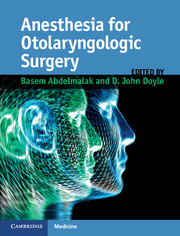Book contents
- Anesthesia for Otolaryngologic Surgery
- Anesthesia for Otolaryngologic Surgery
- Copyright page
- Dedication
- Contents
- Foreword
- Foreword 2
- Contributors
- Preface
- Section 1 Introduction
- Chapter 1 Clinical head and neck anatomy for the anesthesiologist
- Chapter 2 Otolaryngology instruments 101 for the anesthesiologist
- Chapter 3 Preoperative evaluation for ENT surgery
- Chapter 4 The difficult airway in otolaryngology
- Chapter 5 Preoperative endoscopic airway examination
- Chapter 6 Awake intubation
- Chapter 7 Anesthesia for ENT trauma
- Chapter 8 Anesthesia for ENT emergencies
- Chapter 9 Airway pathology in otolaryngology: anesthetic implications
- Chapter 10 Use of Heliox in managing stridor: an ENT perspective
- Chapter 11 Prevention and management of airway fires
- Section 2 Anesthesia for nasal, sinus and pituitary surgery
- Section 3 Anesthesia for head and neck surgery
- Section 4 Anesthesia for laryngotracheal surgery
- Section 5 Anesthesia for bronchoscopic surgery
- Section 6 Anesthesia for Pediatric ENT Surgery
- Index
Chapter 4 - The difficult airway in otolaryngology
from Section 1 - Introduction
Published online by Cambridge University Press: 05 November 2012
- Anesthesia for Otolaryngologic Surgery
- Anesthesia for Otolaryngologic Surgery
- Copyright page
- Dedication
- Contents
- Foreword
- Foreword 2
- Contributors
- Preface
- Section 1 Introduction
- Chapter 1 Clinical head and neck anatomy for the anesthesiologist
- Chapter 2 Otolaryngology instruments 101 for the anesthesiologist
- Chapter 3 Preoperative evaluation for ENT surgery
- Chapter 4 The difficult airway in otolaryngology
- Chapter 5 Preoperative endoscopic airway examination
- Chapter 6 Awake intubation
- Chapter 7 Anesthesia for ENT trauma
- Chapter 8 Anesthesia for ENT emergencies
- Chapter 9 Airway pathology in otolaryngology: anesthetic implications
- Chapter 10 Use of Heliox in managing stridor: an ENT perspective
- Chapter 11 Prevention and management of airway fires
- Section 2 Anesthesia for nasal, sinus and pituitary surgery
- Section 3 Anesthesia for head and neck surgery
- Section 4 Anesthesia for laryngotracheal surgery
- Section 5 Anesthesia for bronchoscopic surgery
- Section 6 Anesthesia for Pediatric ENT Surgery
- Index
Summary
- Type
- Chapter
- Information
- Anesthesia for Otolaryngologic Surgery , pp. 36 - 49Publisher: Cambridge University PressPrint publication year: 2012

